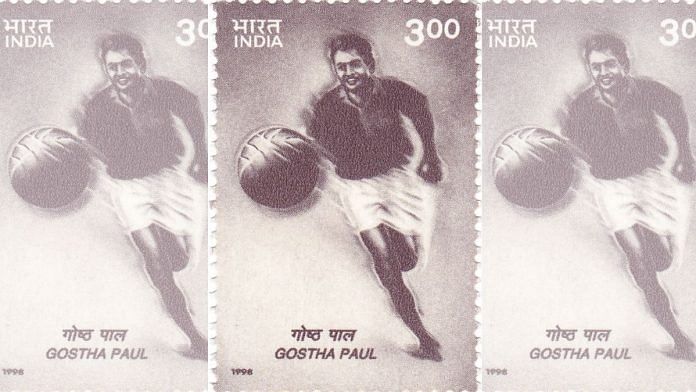It was said to have been raining heavily that day in 1911 when Kalicharan Mitra, a member of the English-dominated Indian Football Association at the time, stopped at Kumartuli Park in Calcutta to watch a practice match. It’s where he saw a young Gostha Pal play football.
Pal became one of the most celebrated football players in the Indian subcontinent and the longest-serving captain of the Mohun Bagan football club. Popularly called ‘Chiner Pacheer’ or ‘The Great Wall of China,’ Pal was one of the best defenders of contemporary Indian football. His no-holds-barred tackles were the stuff of legends, and he did it barefoot.
Awarded the Padma Shri in 1962, Pal’s life-size statue was erected at Kolkata Maidan to honour his legacy in 1984. He became the first Indian footballer to have a postage stamp dedicated to him—such was his stature.
But in cricket-crazy India, Pal’s contribution to Indian football is remembered only by fans. “No one remembers him actually, and his legacy is forgotten,” his son Nirangshu told the Times of India back in 2009.
Also read: Abdul Hamid’s bravery in destroying Pakistani tanks at Asal Uttar ensured his legacy
Born glorious
Gostha Pal was born on 20 August 1896 in Faridpur (now in Bangladesh). When he was 11 years old, Pal began playing football for the Kumartuli Club, where he was discovered by Mitra. But his first match representing Mohun Bagan against Dalhousie FC wasn’t what he expected. He was a 17-year-old unknown player in front of a critical crowd. The field was slushy and his performance was far from stellar.
But with guidance from footballers such as Bhuti Sukul and Rajen Sen, Pal started coming into the game, and soon became a force to reckon with. He proved his detractors wrong and shone in his second match against Team Black Watch— reigning champions of the Calcutta Football League.
In 1915, he played in the club’s first-ever division match against Calcutta FC and finished fourth in the Calcutta Football League. The next year, the team was able to achieve a runner-up position in the same league.
Also read: ‘Acting is not for you’—how Rajendra Kumar braved rejection to become Bollywood’s Jubilee King
Beginning of an illustrious career
Come 1921, Pal was made the captain of Mohun Bagan, a position he proudly and justifiably held for five years. He led his team into the finals of the India Football Association Shield Trophy but once again, finished second to Calcutta FC. It was under Pal’s leadership that Mohun Bagan became the first Indian team to reach the finals of the Rovers Cup in 1923.
Subsequently, in 1924, Pal was offered the captaincy of the Indian National Squad, which had both Indian and British players. By 1933, the captain had led his team to victory, registering a 1-0 win against Sri Lanka—nine years after their first international tour, where they finished second despite a remarkable effort.
Also read: You know British spy Noor Inayat Khan who Hitler executed. Her father has a story too
Continuing legacy
While Gostha Pal continued to draw crowds, by the 1930s, his formidable physique began to show signs of ageing, wrote TheHardTackle. By 1935, Gostha Pal had retired, replaced by his ardent fan and teammate Sanmata Dutt. However, it wasn’t ageing that ended Pal’s glorious career in professional football. “What a lot of people don’t know about him is that just before he retired from football, there was one particular match that the Mohun Bagan team had against the Calcutta FC,” his son told The Better India.
Tired of discrimination and erroneous decisions by referees due to possible racial bias, Pal urged his team to lie face down on the field and refuse to play the 1935 match. The British-led Indian Football Association wanted to take action against him, but Pal walked away before they announced their decision, bidding adieu to the very sport he had grown up with, says Kaushik Bandyopadhyay in his book, Scoring off the Field: Football Culture in Bengal, 1911-80.
Pal was an unfettered player—he played barefoot against opponents who were playing with shoes. Pal redefined Indian football, and according to the Indian Football Association (WB) “remains as an uncontested manual for success in the game.”
In 2004, Mohun Bagan posthumously awarded Pal with the Mohun Bagan Ratna, but his family returned it in 2019, citing “lackadaisical attitude of the club towards the legend’s memorabilia.”
One can see slivers of Pal and his never-say-never attitude throughout Kolkata to this day— in statues and streets. Rabindranath Tagore, a man who knew nothing of football, knew everything of Gostha Pal. “I see, you are Goshto Pal, the ‘Chinese Wall’.”
(Edited by Zoya Bhatti)



